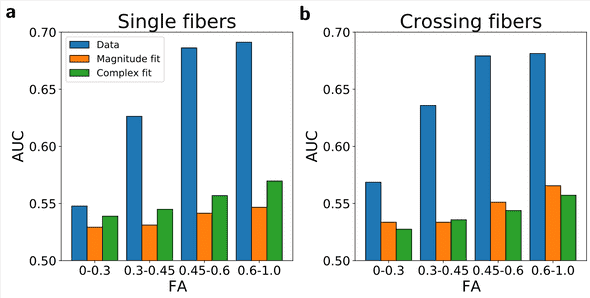My first-author paper “The role of spatial embedding in mouse brain networks constructed from diffusion tractography and tracer injections” has been published online as a preprint at bioRxiv.
Highlights
- A model-free asymmetry metric shows promising performance classifying control- from dysmyelinated white matter voxels.
- After fitting the same data to common time-domain biophysical models, classification performance is reduced.
- This demonstrates biases in the underlying models and motivates future development of spectral analysis methods
Motivation
Echo-planar spectroscopic imaging (EPSI) (AKA multi-gradient echo) is a form of MRI imaging that yields a water resonance spectrum at every point in 3D space. These data are commonly fit to time-domain biophysical signal models in order to estimate relative volumes of myelin, a lipid bilayer that coats axons and is implicated in various dysmyelination disorders such as multiple sclerosis.
The purpose of this project was to demonstrate that with extended temporal sampling of the EPSI data, a model-free approach outperforms common model-based approaches in terms of classifying the presence of myelin.
Our dataset included 5 control mice brains and 4 “shiverer” mice brains. “Shiverer” mice have compromised myelin sheaths around their axons, allowing us to isolate the presence of myelin in our analysis.
Strategy
Based on previous work, we focus on spectral asymmetry as our primary univariate classifier of myelin. We compare spectral asymmetry measured directly from the EPSI data to the asymmetry of spectra predicted after fitting time-domain data to two biophysical models.
We also used several metrics from diffusion MRI acquisitions to explore the models’ performance under different microstructural environments, including a white-matter integrity metric called fractional anisotropy (FA), as well as an indicator of whether or not a voxel contains a single or multiple crossing fiber populations.
Results
At all FA levels and in voxels with both single and crossing fibers, the model-free asymmetry had a much higher area under the ROC curve (AUC) than either of the model-based approaches:
The model-free sensitivity to myelin was also notably higher when looking at spectral asymmetry images, where the model-free (“Data”) image shows notably higher white-matter contrast than either of the model-based approaches:
Our results confirm biases in existing, common biophysical models and promote the further development of spectral analysis methods to benchmark new model-based approaches.


